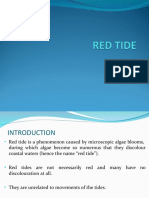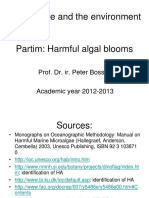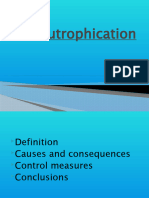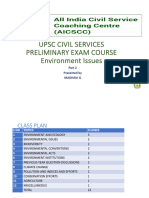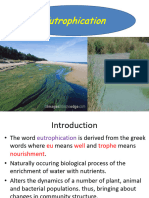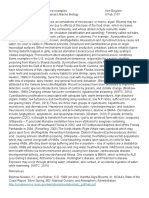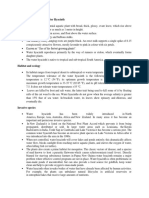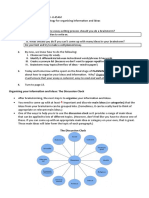0 ratings0% found this document useful (0 votes)
29 viewsHarmful Algal Blooms (HAB) : and Its Effects On The Environment
Harmful Algal Blooms (HAB) : and Its Effects On The Environment
Uploaded by
ckm84Harmful algal blooms (HABs), also known as red tides, are algal blooms that negatively impact other organisms through production of toxins, mechanical damage, oxygen depletion, or other means. HABs are caused by factors like eutrophication, water pollution, optimal temperatures, and stable nutrient-rich conditions. They can cause shellfish poisoning in humans, respiratory issues, and economic losses through fishery and tourism impacts. Prevention strategies include reducing nutrient runoff through better agricultural practices and wastewater treatment.
Copyright:
© All Rights Reserved
Available Formats
Download as PPTX, PDF, TXT or read online from Scribd
Harmful Algal Blooms (HAB) : and Its Effects On The Environment
Harmful Algal Blooms (HAB) : and Its Effects On The Environment
Uploaded by
ckm840 ratings0% found this document useful (0 votes)
29 views14 pagesHarmful algal blooms (HABs), also known as red tides, are algal blooms that negatively impact other organisms through production of toxins, mechanical damage, oxygen depletion, or other means. HABs are caused by factors like eutrophication, water pollution, optimal temperatures, and stable nutrient-rich conditions. They can cause shellfish poisoning in humans, respiratory issues, and economic losses through fishery and tourism impacts. Prevention strategies include reducing nutrient runoff through better agricultural practices and wastewater treatment.
Original Description:
ok
Original Title
Presentation 1
Copyright
© © All Rights Reserved
Available Formats
PPTX, PDF, TXT or read online from Scribd
Share this document
Did you find this document useful?
Is this content inappropriate?
Harmful algal blooms (HABs), also known as red tides, are algal blooms that negatively impact other organisms through production of toxins, mechanical damage, oxygen depletion, or other means. HABs are caused by factors like eutrophication, water pollution, optimal temperatures, and stable nutrient-rich conditions. They can cause shellfish poisoning in humans, respiratory issues, and economic losses through fishery and tourism impacts. Prevention strategies include reducing nutrient runoff through better agricultural practices and wastewater treatment.
Copyright:
© All Rights Reserved
Available Formats
Download as PPTX, PDF, TXT or read online from Scribd
Download as pptx, pdf, or txt
0 ratings0% found this document useful (0 votes)
29 views14 pagesHarmful Algal Blooms (HAB) : and Its Effects On The Environment
Harmful Algal Blooms (HAB) : and Its Effects On The Environment
Uploaded by
ckm84Harmful algal blooms (HABs), also known as red tides, are algal blooms that negatively impact other organisms through production of toxins, mechanical damage, oxygen depletion, or other means. HABs are caused by factors like eutrophication, water pollution, optimal temperatures, and stable nutrient-rich conditions. They can cause shellfish poisoning in humans, respiratory issues, and economic losses through fishery and tourism impacts. Prevention strategies include reducing nutrient runoff through better agricultural practices and wastewater treatment.
Copyright:
© All Rights Reserved
Available Formats
Download as PPTX, PDF, TXT or read online from Scribd
Download as pptx, pdf, or txt
You are on page 1of 14
Harmful Algal Blooms (HAB)
And its effects on the environment
Harmful Algae Blooms
A harmful algal bloom (HAB) is an algal bloom
that causes negative impacts to other
organisms via production of natural toxins,
mechanical damage to other organisms, or by
other means. HABs are often associated with
large-scale marine mortality events and have
been associated with various types of shellfish
poisonings.
Description
Harmful Algal Blooms (HAB) (also known as red
tides)is an algal bloom that causes negative
impacts to other organisms via:
Production of natural toxins
Mechanical damage to other organisms
Hypoxia (Oxygen Depletion)
By other means
In recent years, there has been growing alarm
over what appears to he an "epidemic" of HABs
worldwide.
Causes of HAB
Harmful algal blooms can be due to a number of reasons:
Eutrophication
Water pollution
Transfer of shellfish for aquaculture
Transportation from ships' ballast water
Low Turbidity
Optimal temperature (Eg :25 C are optimal for the growth of
bluegreen algae)
Stable conditions (low flows, long retention times, light winds
and minimal turbulence)
The growth of marine phytoplankton (both non-toxic and toxic)
is generally limited by the availability of nitrates and
phosphates, which can be abundant in coastal upwelling zones
as well as in agricultural run-off and other human activities.
How do cyanobacterial blooms form?
Cyanobacteria also known as blue-green bacteria, blue-green
algae, and Cyanophyta, is a phylum of bacteria that obtain
their energy through photosynthesis. The name
"cyanobacteria" comes from the color of the bacteria.
Cyanobacterial blooms occur when algae that are normally
present grow exuberantly. Within a few days, a bloom can
cause clear water to become cloudy.
The blooms usually float to the surface and can be many
inches thick, especially near the shoreline. Cyanobacterial
blooms can form in warm, slow-moving waters that are rich in
nutrients such as fertilizer runoff or septic tank overflows.
Blooms can occur at any time, but most often occur in late
summer or early fall.
Effects of HAB on Human Health
Humans get infected primarily by HAB toxins that are present in shellfish.
Some HAB toxins can become airborne during a bloom and people can
become ill by inhaling toxins.
Shellfish poisoning
Amnesic shellfish poisoning (ASP)
Diarrheal shellfish poisoning (DSP)
Neurotoxic shellfish poisoning (NSP)
Paralytic shellfish poisoning (PSP)
Ciguatera sh poisoning
Pfiesteria
Most symptoms of HAB act primarily on the nervous system and are
permanent.
Common symptoms of HAB are diarrhoea, vomiting, abdominal pain,
nausea and headaches.
Effects Of HAB on the Economy
Closures of shellfish beds
Lost production in fisheries
Severe reductions in local/regional tourism
and associated service industries
Public illness
Medical treatments
Advisories
Prevention of HAB
Replanting of riparian forests (forest adjacent to a body
of water)
Silt fence
Detention basin
Retention basin
Water treatment
Reducing the nutrient load of a water body:
Avoiding the excessive use of fertilisers and manures on
agricultural land within the catchment.
Protecting soil from erosion.
Treating sewage to remove the nutrients nitrogen and
phosphorus.
You might also like
- Nesic - Environmental Weekly Checklist: Inspection Conducted by Position Date of Inspection LocationDocument4 pagesNesic - Environmental Weekly Checklist: Inspection Conducted by Position Date of Inspection LocationMuhammad Waqas83% (6)
- Water Pollution PresentationDocument35 pagesWater Pollution PresentationJeshwary KumarNo ratings yet
- Human Activities and Their Impacts On BiodiversityDocument33 pagesHuman Activities and Their Impacts On Biodiversitybutterfily75% (4)
- Assignment 8: Name: Alpapikabaka Section: Bs Crim 1Document3 pagesAssignment 8: Name: Alpapikabaka Section: Bs Crim 1Asuna Yuuki50% (2)
- Toxic Diatoms & DinoflagellatesDocument28 pagesToxic Diatoms & DinoflagellatesNaina KalraNo ratings yet
- 5 Water Pollution 4Document27 pages5 Water Pollution 4Ňáťh ĐùmìñdâNo ratings yet
- Algal Bloom pptDocument15 pagesAlgal Bloom pptdebadattamerliNo ratings yet
- Red TideDocument10 pagesRed TideKyle DelizoNo ratings yet
- Water Ecology Unit 1Document30 pagesWater Ecology Unit 1सुनिल बाबु खत्रीNo ratings yet
- Eutrophication (T11)Document48 pagesEutrophication (T11)Siti SuhailahNo ratings yet
- Algal BloomDocument4 pagesAlgal BloomDEVI TEJASWININo ratings yet
- Department of Zoology: MaricultureDocument21 pagesDepartment of Zoology: Mariculturesaman aslamNo ratings yet
- What Causes WPDocument22 pagesWhat Causes WPAnonymous VIZNI30PYNo ratings yet
- Redtide: Harmful Algal BloomDocument11 pagesRedtide: Harmful Algal BloomJohanne May Capitulo LopezNo ratings yet
- Algae & CyanoDocument63 pagesAlgae & CyanoHarshvardhan ZalaNo ratings yet
- Water PollutionDocument5 pagesWater PollutionPrivateNo ratings yet
- P2u2 - Enviromental ChemistryDocument26 pagesP2u2 - Enviromental ChemistryAyush VoraNo ratings yet
- Aquatic Biotoxins in Seafood and Fresh WaterDocument23 pagesAquatic Biotoxins in Seafood and Fresh WaterMd. Sazzad HossainNo ratings yet
- Effects of Water PollutionDocument8 pagesEffects of Water PollutionJasvinder SinghNo ratings yet
- Aquaculture and The Environment: Prof. Dr. Ir. Peter BossierDocument221 pagesAquaculture and The Environment: Prof. Dr. Ir. Peter BossierHassanKMNo ratings yet
- A4 EutrophicationDocument2 pagesA4 EutrophicationRovv icNo ratings yet
- EutrophicationDocument22 pagesEutrophicationdelight photostateNo ratings yet
- Chapter 1 WaterhandlingDocument30 pagesChapter 1 WaterhandlingAvashti LontokNo ratings yet
- Unit-3 Part-Ii EvsDocument121 pagesUnit-3 Part-Ii Evskeshav GuptaNo ratings yet
- 4.4 Water PollutionDocument11 pages4.4 Water PollutionBharti JhaNo ratings yet
- Nrpextracredit2 1Document4 pagesNrpextracredit2 1api-300527410No ratings yet
- Environment Issues Part 2Document47 pagesEnvironment Issues Part 2thangasachithananthan.rvsNo ratings yet
- Harmful Algal BloomDocument5 pagesHarmful Algal BloomZannatul NayemaNo ratings yet
- Water PollutionDocument27 pagesWater PollutionRangerNo ratings yet
- Effects of Water Pollution 2Document4 pagesEffects of Water Pollution 2Jasvinder SinghNo ratings yet
- Work BiolllogyDocument11 pagesWork BiolllogySiti NuraienaNo ratings yet
- Toxic Algae Diseases (Fish 6)Document7 pagesToxic Algae Diseases (Fish 6)alhafeed073No ratings yet
- 1 - Ballast Water and IAS - Murat KorcakDocument37 pages1 - Ballast Water and IAS - Murat Korcaksara dazzlingNo ratings yet
- Algaltoxinspond PDFDocument8 pagesAlgaltoxinspond PDFBhargavi ThatikondaNo ratings yet
- Lec-Notes - RED-TIDE (1) - 095553Document4 pagesLec-Notes - RED-TIDE (1) - 095553gjester797No ratings yet
- Water PollutionDocument53 pagesWater PollutionDileep1489No ratings yet
- FSA 353 - 26th PDFDocument52 pagesFSA 353 - 26th PDFphaniezaongoNo ratings yet
- Pollution and It's TypesDocument38 pagesPollution and It's TypesMUHAMMAD AHMED ALI ABBASINo ratings yet
- Algae - What 2 PageDocument2 pagesAlgae - What 2 PageVignesh LalNo ratings yet
- Water PollutionDocument27 pagesWater PollutionKarylleNo ratings yet
- Impact of Untreated Waste Water On BiodiversityDocument18 pagesImpact of Untreated Waste Water On BiodiversityNaini Burman100% (5)
- Cyano Mitigation GlobalHAB2019Document19 pagesCyano Mitigation GlobalHAB2019Mario AguilarNo ratings yet
- WaterpollutiontypesDocument39 pagesWaterpollutiontypesfahimhoque.fmNo ratings yet
- PollutionDocument23 pagesPollutionkaiya mollenthielNo ratings yet
- Algal Blooms and ToxinsDocument15 pagesAlgal Blooms and ToxinsMonal SinghalNo ratings yet
- Lect 5-6 EutrophicationDocument34 pagesLect 5-6 Eutrophicationa195426No ratings yet
- EutrophicationDocument22 pagesEutrophicationjeonkiloversNo ratings yet
- Water PollutionDocument38 pagesWater PollutionmikramNo ratings yet
- Biodiversity NotesDocument29 pagesBiodiversity NotesTrishia Faith DemetrioNo ratings yet
- Water - Pollution - and - Freshwater - Fish Semana 3, 4 PDFDocument27 pagesWater - Pollution - and - Freshwater - Fish Semana 3, 4 PDFJosé Carlos Solís SuárezNo ratings yet
- Presentation On Marine Pollution: Presented ByDocument22 pagesPresentation On Marine Pollution: Presented BySourav Agrawal86% (7)
- Algal BloomsDocument3 pagesAlgal BloomsAroma MangaoangNo ratings yet
- EutrophicationDocument17 pagesEutrophicationMarvel AvengersNo ratings yet
- Coast Report. Silver Spring, MD: National Oceanic and Atmospheric AdministrationDocument2 pagesCoast Report. Silver Spring, MD: National Oceanic and Atmospheric AdministrationbixgorinNo ratings yet
- Study and Assessment of An Eutrophied Inland Water BodyDocument73 pagesStudy and Assessment of An Eutrophied Inland Water BodyAnu CherianNo ratings yet
- Lecture 3 - Biodiversity - Threats To BiodiversityDocument20 pagesLecture 3 - Biodiversity - Threats To BiodiversitySimphiweNo ratings yet
- 2022 04 DMSD Modifikasi Dan Degradasi HabitatDocument34 pages2022 04 DMSD Modifikasi Dan Degradasi HabitatRiangga Afif AmrullohNo ratings yet
- Environment 11 - Daily Class Notes - (Sankalp (UPSC 2024) )Document5 pagesEnvironment 11 - Daily Class Notes - (Sankalp (UPSC 2024) )WHITE SHADOWNo ratings yet
- Freshwater Algal BloomsDocument3 pagesFreshwater Algal BloomsVitoo OinamNo ratings yet
- Eichhornia Crassipes or Water HyacinthDocument5 pagesEichhornia Crassipes or Water HyacinthJamilah AbdulmaguidNo ratings yet
- Chan Shin Woan - TP PDFDocument30 pagesChan Shin Woan - TP PDFckm84No ratings yet
- How To Use USM Student EmailDocument2 pagesHow To Use USM Student Emailckm84No ratings yet
- Section A Questions 1 - 4: Read The Text and Choose The Best Word Based On The Picture GivenDocument14 pagesSection A Questions 1 - 4: Read The Text and Choose The Best Word Based On The Picture Givenckm84No ratings yet
- Mat 1 PerakDocument16 pagesMat 1 Perakckm84No ratings yet
- An Inconvenient TruthDocument3 pagesAn Inconvenient TruthNadine100% (1)
- Virtual Water Testing and TreatmentDocument3 pagesVirtual Water Testing and Treatmentapi-2366978200% (1)
- M5 Post Task NSTPII Ocdol BSMT2A PDFDocument6 pagesM5 Post Task NSTPII Ocdol BSMT2A PDFPRECIOUS LOVE LAGRIMASNo ratings yet
- Puc Certificate NewDocument1 pagePuc Certificate NewAakash ShishodiaNo ratings yet
- Annexure 2 Star Rating 3 Star Matrix-1Document1 pageAnnexure 2 Star Rating 3 Star Matrix-1akashNo ratings yet
- Finished UCSPDocument7 pagesFinished UCSPcarmela chanNo ratings yet
- Oceans Are Giant SpongesDocument2 pagesOceans Are Giant SpongesMarc Christian Paraan FernandezNo ratings yet
- Eldo PPT-IndianStandards WWTDocument40 pagesEldo PPT-IndianStandards WWTRushikesh NaikNo ratings yet
- ĐỀ CHUẨN MINH HỌA SỐ 34Document5 pagesĐỀ CHUẨN MINH HỌA SỐ 34Dao Ngoc AnhNo ratings yet
- Writing Task 3 - Discussion ClockDocument3 pagesWriting Task 3 - Discussion ClockOwen TingNo ratings yet
- Global Warming: Presented By: Jassim Mohammad Sections: CTB ID: H00098495Document11 pagesGlobal Warming: Presented By: Jassim Mohammad Sections: CTB ID: H00098495jassem2003No ratings yet
- MSDS Swarfega Orange - English (UK ROI)Document5 pagesMSDS Swarfega Orange - English (UK ROI)Myo SeinNo ratings yet
- ADC Compliance Obligation 2023Document6 pagesADC Compliance Obligation 2023kazuopaul.sardonNo ratings yet
- Envizi L4 POX - IPCC GWPsDocument3 pagesEnvizi L4 POX - IPCC GWPszvranicNo ratings yet
- Sen. Cohen Tweed Airport EIS Letter To FAA Oct. 21Document2 pagesSen. Cohen Tweed Airport EIS Letter To FAA Oct. 21Ellyn SantiagoNo ratings yet
- Climate Change Is The Greatest Threat Facing Humanity TodayDocument2 pagesClimate Change Is The Greatest Threat Facing Humanity TodayJoshua Metre CajotocNo ratings yet
- Project Environmental Monitoring and Audit Prioritization Scheme (Pemaps) QuestionnaireDocument4 pagesProject Environmental Monitoring and Audit Prioritization Scheme (Pemaps) QuestionnaireEsgra CulkinNo ratings yet
- Global Warming IntroductionDocument7 pagesGlobal Warming IntroductionAlex100% (39)
- Pollutant-Specific Cautionary Statements For The Air Quality IndexDocument1 pagePollutant-Specific Cautionary Statements For The Air Quality Indexmithilesh5103No ratings yet
- Environmental Impact Assessment (EIA) : Dr. Hassan El ShimiDocument38 pagesEnvironmental Impact Assessment (EIA) : Dr. Hassan El ShimiKarim SamhyNo ratings yet
- Different Types of WasteDocument4 pagesDifferent Types of WasteKelly Misha NoolNo ratings yet
- Science Technology and SocietyDocument10 pagesScience Technology and SocietyAsteria TimeNo ratings yet
- Evs Commerce Project-AssignmentDocument9 pagesEvs Commerce Project-AssignmentPratham ShahNo ratings yet
- Environmental Conservation and ManagementDocument20 pagesEnvironmental Conservation and ManagementBangit JhayvieNo ratings yet
- Deforestation Written ReportDocument5 pagesDeforestation Written ReportJanae Cruxette RamosNo ratings yet
- Climate Change 1-4Document11 pagesClimate Change 1-4Denise Michaela YapNo ratings yet
- Food WasteDocument4 pagesFood WasteAngel MahiyaNo ratings yet
- Biomagnification: A Report OnDocument13 pagesBiomagnification: A Report OnHarsh RawatNo ratings yet







